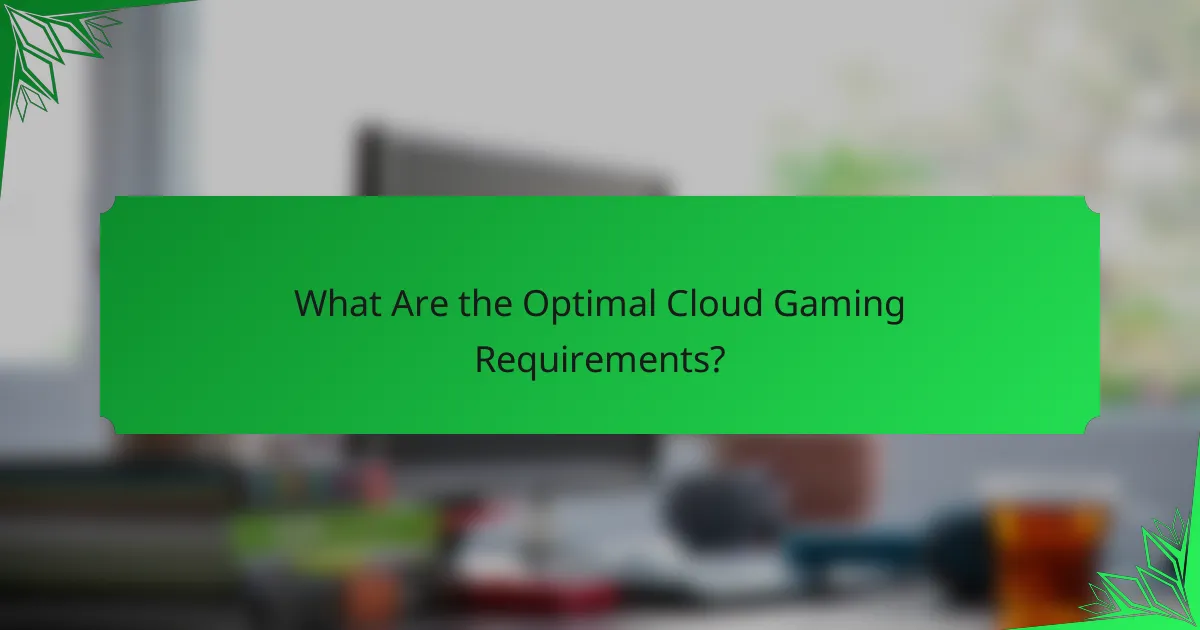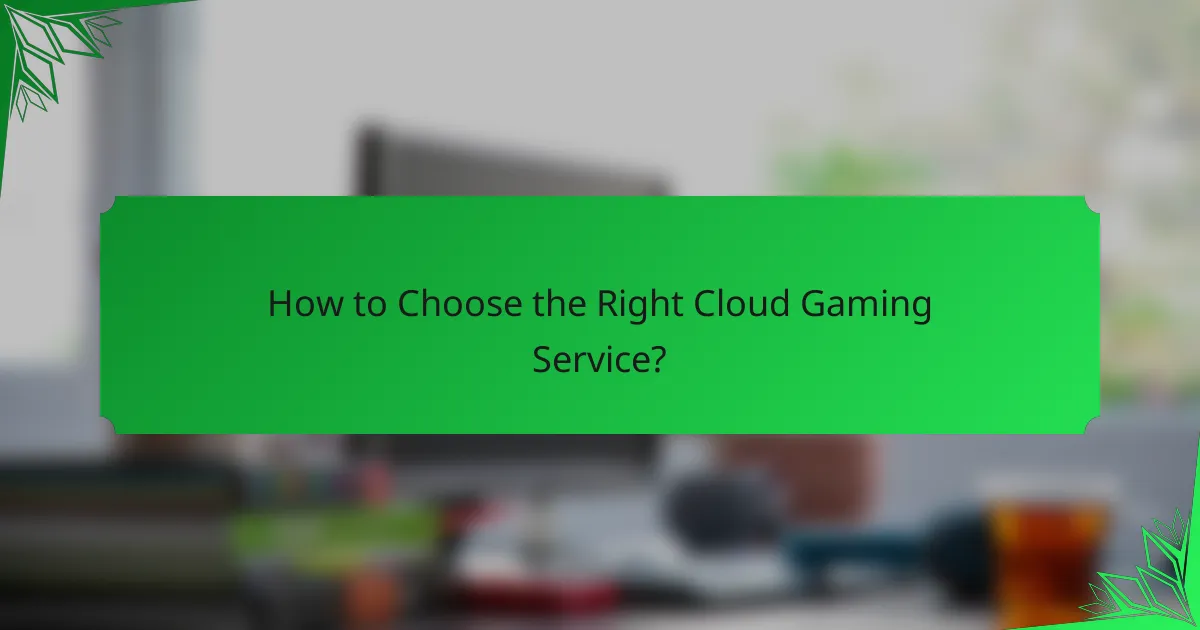To enjoy a seamless cloud gaming experience, it’s essential to meet optimal requirements that focus on bandwidth, latency, and compatible hardware. By ensuring these specifications are met, gamers can significantly reduce lag and enhance performance. Additionally, selecting the right cloud gaming service is crucial, as it should align with personal preferences while providing a stable connection for the best gameplay experience.

What Are the Optimal Cloud Gaming Requirements?
The optimal cloud gaming requirements ensure a seamless gaming experience by focusing on bandwidth, latency, hardware, and device compatibility. Meeting these specifications helps reduce lag and improve overall performance during gameplay.
Minimum bandwidth of 15 Mbps
A minimum bandwidth of 15 Mbps is essential for cloud gaming to function effectively. This speed allows for smooth video streaming and responsive gameplay, reducing the chances of buffering or lag. For a better experience, consider higher speeds, especially if multiple devices are using the same connection.
To check your bandwidth, use online speed tests that measure download and upload speeds. If your results are consistently below 15 Mbps, consider upgrading your internet plan or optimizing your network setup.
Low latency under 30 ms
Low latency, ideally under 30 ms, is crucial for cloud gaming as it measures the delay between your input and the game’s response. High latency can lead to noticeable lag, making games feel unresponsive and frustrating. Aim for a wired connection, as it typically offers lower latency compared to Wi-Fi.
To achieve low latency, minimize network congestion by limiting the number of active devices during gaming sessions. Additionally, consider using quality of service (QoS) settings on your router to prioritize gaming traffic.
Recommended hardware specifications
For optimal cloud gaming, your hardware should include a modern processor, at least 8 GB of RAM, and a dedicated graphics card. These components help ensure that your device can handle the streaming service’s demands while providing a smooth experience. Regularly updating your hardware can also enhance performance.
Check the specifications recommended by your chosen cloud gaming service, as they may vary. Investing in a solid-state drive (SSD) can also improve load times and overall responsiveness.
Supported devices for cloud gaming
Cloud gaming is compatible with a variety of devices, including PCs, laptops, gaming consoles, and mobile devices. Most services offer apps for popular platforms, making it easy to access games on the go. Ensure your device meets the minimum requirements set by the cloud gaming provider.
Before committing to a service, verify the list of supported devices and any specific operating system requirements. This will help you avoid compatibility issues and ensure a smooth gaming experience across your preferred platforms.

How to Choose the Right Cloud Gaming Service?
Choosing the right cloud gaming service involves evaluating factors like performance, game selection, and pricing. Prioritize services that align with your gaming preferences and offer a stable connection for the best experience.
Comparison of popular platforms
Several cloud gaming platforms are available, each with unique features. Services like NVIDIA GeForce NOW, Xbox Cloud Gaming, and PlayStation Now are among the most popular, offering a range of games and performance levels.
When comparing platforms, consider factors such as latency, resolution support, and device compatibility. For instance, NVIDIA GeForce NOW excels in graphics quality, while Xbox Cloud Gaming integrates seamlessly with Xbox Game Pass.
Pricing models and subscription options
Cloud gaming services typically offer various pricing models, including monthly subscriptions and pay-per-use options. For example, Xbox Cloud Gaming is often bundled with Xbox Game Pass, providing access to a large library for a fixed monthly fee.
Be aware of potential hidden costs, such as purchasing individual games or needing specific hardware. Look for trials or introductory offers to test services before committing to a subscription.
Game library and compatibility
The game library is a crucial aspect of any cloud gaming service. Ensure the platform you choose has the titles you want to play, as libraries can vary significantly. For instance, PlayStation Now features a strong lineup of PlayStation exclusives, while GeForce NOW allows you to play games you already own on platforms like Steam.
Compatibility with your devices is also essential. Most services support a range of devices, including PCs, consoles, and mobile phones, but check for specific requirements to avoid disappointment. Some platforms may require a controller for optimal gameplay, while others can be played with a keyboard and mouse.

What Are the Benefits of Cloud Gaming?
Cloud gaming offers several advantages, including enhanced accessibility, reduced hardware requirements, and immediate access to games and updates. These benefits make gaming more convenient and flexible for users across various platforms.
Accessibility on multiple devices
Cloud gaming allows players to access their favorite games on a range of devices, from smartphones and tablets to laptops and smart TVs. This flexibility means you can enjoy gaming at home or on the go without being tied to a specific console or PC.
Many cloud gaming services support cross-platform play, enabling users to switch between devices seamlessly. For example, you can start a game on your laptop and continue on your mobile device without losing progress.
No need for high-end hardware
One of the most significant benefits of cloud gaming is that it eliminates the need for expensive gaming hardware. Since the processing is done on remote servers, players can enjoy high-quality graphics and performance without investing in a powerful gaming PC or console.
This accessibility means that even users with older devices can participate in gaming experiences that would typically require advanced specifications. As long as you have a stable internet connection, you can play demanding titles without the associated costs of upgrading hardware.
Instant game access and updates
Cloud gaming platforms provide immediate access to a vast library of games, allowing players to start playing without lengthy downloads or installations. This instant access can significantly enhance the gaming experience, especially for those eager to try new titles.
Additionally, updates and patches are managed automatically by the service, ensuring that players always have the latest version of their games without needing to manually download updates. This feature saves time and ensures a smoother gaming experience overall.

What Are the Common Issues with Cloud Gaming?
Common issues with cloud gaming include connection stability problems, input lag, and limited game selection on certain platforms. These challenges can significantly affect the overall gaming experience, making it crucial for users to understand and address them.
Connection stability problems
Connection stability is vital for cloud gaming, as interruptions can lead to lag or disconnections. A stable internet connection with a speed of at least 15 Mbps is generally recommended for smooth gameplay. Users should consider using wired connections over Wi-Fi to minimize fluctuations.
Additionally, network congestion during peak hours can exacerbate stability issues. To mitigate this, gamers can schedule their playtime during off-peak hours or prioritize bandwidth for gaming devices through router settings.
Input lag and performance issues
Input lag occurs when there is a delay between a player’s action and the game’s response, which can be frustrating in fast-paced games. Aiming for a latency of under 30 milliseconds is ideal for an enjoyable experience. This can be influenced by both internet speed and the distance to the cloud server.
Performance issues may also arise from the hardware capabilities of the device being used. Ensuring that the device meets or exceeds the minimum specifications for cloud gaming platforms can help reduce these problems.
Limited game selection on some platforms
Some cloud gaming services offer a limited library of games compared to traditional consoles or PC gaming. This can restrict players from accessing their favorite titles or new releases. It’s essential to research the game library of a service before committing to a subscription.
Additionally, licensing agreements can affect game availability, meaning that certain popular games may not be offered on all platforms. Users should consider trying out free trials or checking for exclusive titles that may enhance their gaming experience.

What Are the Future Trends in Cloud Gaming?
Future trends in cloud gaming focus on enhanced performance, accessibility, and immersive experiences. As technology evolves, users can expect improved streaming quality, integration with virtual and augmented reality, and broader device compatibility.
Advancements in streaming technology
Streaming technology is rapidly advancing, allowing for higher resolutions and lower latency. Innovations like 5G networks and improved compression algorithms enable smoother gameplay, with some services targeting latency as low as 20-30 milliseconds.
These advancements mean that players can enjoy high-quality graphics without the need for expensive hardware. Services are increasingly offering adaptive streaming, which adjusts quality based on the user’s internet speed, ensuring a consistent experience.
Integration with VR and AR experiences
The integration of cloud gaming with virtual reality (VR) and augmented reality (AR) is set to redefine gaming experiences. By leveraging cloud computing, developers can create more immersive environments that require less local processing power.
This trend allows users to access complex VR and AR games on lower-end devices, making these technologies more accessible. For instance, cloud-based VR platforms can stream high-fidelity graphics directly to headsets, reducing the need for powerful gaming rigs.
